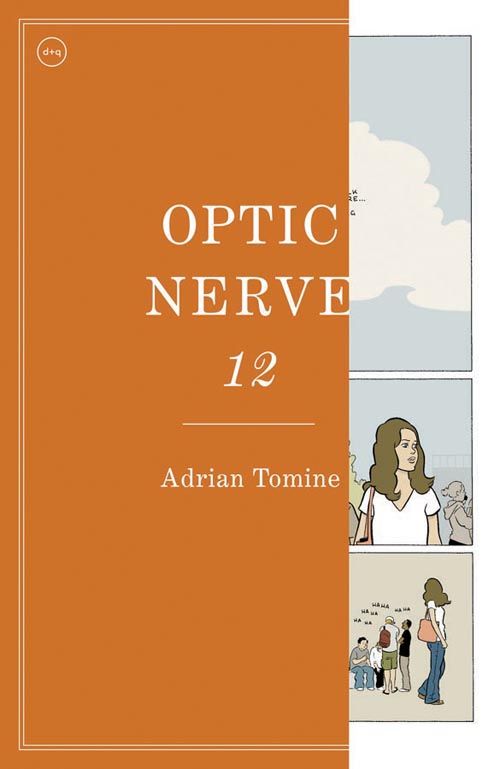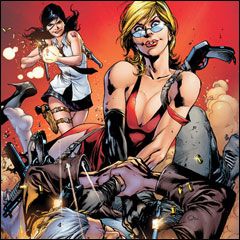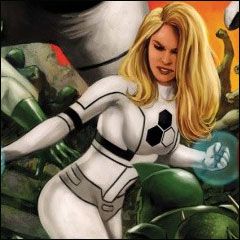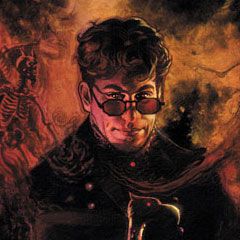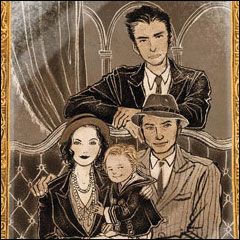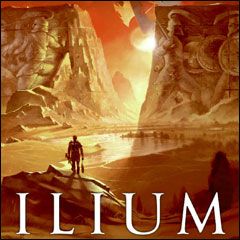Welcome to What Are You Reading? Our special guest today is Chris Duffy, editor of First Second's Nursery Rhyme Comics. We spotlighted this anthology project all week here on Robot 6; check out our interviews with Chris as well as contributors Scott C., Aaron Reiner, Richard Sala and Eleanor Davis.
And to see what Chris and the Robot 6 crew have been reading, click below.
*****
Tim O'Shea
Resurrection Man #2: The writing team of Dan Abnett and Andy Lanning has increasingly grown on me in recent years. But what is really selling me on returning to this series with issue #3 is artist Fernando Dagnino. Whether intentional on his part or not, there are moments that Dagnino’s approach with this book reminds of Butch Guice’s style (the artist on the initial RM run).
Mister Terrific #2: After I read this issue, I mentally kicked myself for the waste of money. The art on this book is just incredibly rushed and uninspiring (by Gianluca Gugliotta -- which is a shame as he has a two-page splash at one point with the lead character that is quite exquisite), which could be overlooked if Eric Wallace’s plot did not leave me wanting far more.
Batman and Robin #2: Writer Peter Tomasi constructs some great moments between fathers and sons in this issue (Alfred and Bruce, Bruce and Damian). And after thinking that DC editorial had settled Damian into a traditional sidekick role, I was pleasantly surprised to see Tomasi inject a bit of old (character roots) internal good vs. evil conflict back into the character.
Alpha Flight #5: The art of the bait and switch is something that is used to great effect in this series, repeatedly—and I have to tire of it. Also intriguing to see the character dynamics between Taskmaster and Puck. Glad this series has become an ongoing.
FF #10: This is the best art I have seen from Barry Kitson in a very long time. I am unsure if he was experimenting with a change in his style, or had been rushed, on past assignments—but this issue is visually strong thanks to him. And my FF series rule that the title reads better when Sue Richards appears still holds true (she is in this issue). As a 1970s fan who always loved the surprise cliffhanger, this issue ends on a solid note (and no, it’s not Johnny Storm alive).
Super Dinosaur #5: Robert Kirkman writes an appealing all-ages book with this project. Note I said all ages. Yes, my 12-year-old son book will enjoy this book. But of equal importance, his 43-year-old dad was thrown and hooked by the big reveal in this issue.
Uncanny X-Force: The Apocolypse Solution trade paperback: While I have been reading Rick Remender’s Venom series, I had not checked out this series. The NYCC announcement that he would be taking on Secret Avengers (with one of my favorite artists Gabriel Hardman), I thought it would be a good time to consider the writer’s approach on this X-covert title. Fortunately two of my pals at the local comic book store (thanks Dugan and Mike) steered me toward this first trade collection for the series. Artist Jerome Opeña (who I first took note of when he teamed with writer Stuart Moore in 2004 on Dark Horse/Rocket’s Lone) is perfectly suited for these clandestine affairs. And I like that it seems the dirty work this team must do keeps them out of most X-crossovers that occur, making it even more of an accessible read for me.
The Shade #1: Good giggly wiggly, how did I not know that this maxi-series involved one of my favorite artists, Cully Hamner. Call me crazy, but Hamner’s ever-evolving eye for distinctive and cinematic layouts is steadily making him this comics era’s Alex Toth. I have a new theory about James Robinson’s writing (which was last consistently engaging on his long and beloved Starman run), if he can write a story that has a member of the O’Dare family (or maybe it’s the fact he’s back in Opal City), but something in Robinson relaxes and he delivers a solid story (this maxi-series features Shade’s girlfriend, Hope O’Dare). While the issue opens and closes with a simple three-word phrase: “October brings melancholy”—a great deal happens in between that phrase and its repeating. Welcome back, Opal City. Now if someone can just find a way to bring back Sue and Ralph.
Chris Mautner
In preparation for my upcoming big Comics College post on Grant Morrison, I read his entire run on JLA, which I had more or less avoided up until now. To be honest, I wasn't terribly impressed by it and am not quite sure why it's garnered so many accolades. It strikes me overall as very shallow work; very plot heavy and so focused on having a grand, epic narrative that it misses the deeper themes and character touches that I think make Morrison such a noteworthy writer. In short, it's all rather shallow and nowhere where as rich as say, Doom Patrol, or Invisibles. Plus, while I don't like ragging on artists, I must say that Howard Porter's pencils do absolutely nothing for me.
Shade #1 -- Why couldn't the bulk of the new 52 titles be as well plotted and entertaining as this issue? I've never read James Robinson's run on Starman before and know nothing about the Shade, but I found this to be a smartly plotted, entertaining superhero comic that had me curious to eager to find out what happened next. A good deal of this success should be laid at artist Cully Hamner's feet. My only gripe is regarding the gore at the end that seems a bit excessive to me. I feel like a prude complaining about this stuff, but it feels so out of place in an otherwise disarmingly charming comic.
Tom Bondurant
So there I was, enjoying the heck out of Scott Snyder and Sean Murphy's American Vampire: Survival of the Fittest #5, when it hit me -- didn't Brian Azzarello and Cliff Chiang make fun of the whole cool-trend-mashup thing five years ago, when they turned the Nazi Lord Julius into a vampire named Primaul (TM) in "Architecture & Mortality?"
Then I remembered Julius was a Nazi vampire gorilla, and that made it OK.
Kidding aside, SOTF was a really fine adjunct to the main AV series, because man were those Nazi vamps some scary f'ers. Most of issue #5 involves a blow-the-doors-off chase scene, with our heroes using a death ray to melt a path for their motorcycle down the side of a mountain as a giant monster tears into said Nazis and tanks are plummeting off said mountain too closely for comfort. Contrast that with the quiet epilogue, which reminds us why Felicia and Cash were tearing down the mountain in the first place, and you get an excellent example of the skills of all involved.
The Unwritten #30 (written by Mike Carey, drawn by Peter Gross with Vince Locke) was a melancholy, heartbreaking conclusion to the Golden Age arc "On To Genesis." I keep wanting to introduce this series to my friends and family who are Harry Potter fans, but it has gone so far beyond Potter pastiche that the comparison no longer applies. "Genesis" brings together a forgotten superhero and Frankenstein's monster as Tom's friends and allies in his war with the shadowy forces who seek to rule (to keep ruling?) over ... well, over all of human culture and history, I guess. This time, though, the superhero is just one facet of a tragic figure who, like Tom, straddles the line between human being and literary creation. On one hand you're grateful for the life he has, but really it's not that great of a life. The events of the issue provoke a final-page act of defiance from Tom, energizing the series for the next big (biweekly!) arc.
Finally, I've been going truly old-school with my super-team reading, having picked up a copy of All-Star Comics Archives Vol. 1. So far I'm only through the first story, the Justice Society's first appearance in issue #3, but -- and I know how this sounds -- I'm a little surprised at how well it holds up. See, for those who don't know, the first story isn't really a JSA adventure in the way we might think of one. Instead, it's a set of individual adventures united by a framing sequence after Johnny Thunder and his Thunderbolt crash the weekly JSA meeting. (Subsequent stories were apparently more conventional.) What's more, the individual stories were produced by the characters' regular creative teams -- so Gardner Fox and E.E. Hibbard drew the Flash chapter, Fox and Shelly Moldoff drew the Hawkman chapter, Jerry Siegel and Bernard Baily drew the Spectre chapter, etc. This is hardly an uncommon practice today, but it's not what I was used to (having grown up on the Justice League and its fancy-dancy single creative team). In fact I found it pretty charming, especially at the end of each story when a wide-eyed Johnny Thunder would get some reassuring moral from Doctor Fate or the Spectre. I'm not used to supernatural figures, who play with forces which would make mere mortals pee their pants in awe and/or terror, sounding like your favorite uncle. There's eleven more of these Archives, and I have the first of Roy Thomas' All Star Companions as well -- so I may have to buy a new bookshelf....
Chris Duffy
Ilium (novel) by Dan Simmons: I read Hyperion this summer by the same author and ate it up! Ilium is less absorbing at first but it builds curiosity and suspense about the fate of humankind as it goes. It's a book with not one but about 17 high concepts going on at once. (That's what Hyperion was like as well.) Far-flung future. It stars a handful of old-style humans (like us), a group of robots from Jupiter's moons (who are more human than humans), and a resurrected Homeric scholar who it watching the story of the Iliad play out...on Mars. It's actually much stranger than that sounds. This Simmons guy has written a lot and I plan to try more after this.
Action Comics by Morrison and Morales: I really like watching Superman's origin retold with a new twist: Superman is actually an interesting character. You wonder what makes him tick. Plus there's a lot of ACTION. Reminds me a bit of the Tom DeHaven Superman novel (which was great).
Anya's Ghost by Vera Brosgol: I liked it a lot--very well told teenage ghost story (for teens and starring teens, including the ghost).
Duncan the Wonder Dog: I have only read a page, but it looks pretty good. I'm a sucker for stories about animals with human intelligence. That's what this is, right?
Optic Nerve #12: Buy this floppy! Adrian Tomine is one of a kind. This issue has two stories. The first is "Hortisculpture," told in daily strip format with a full page Sunday-style comic after every 6 strips. A middle aged landscaper hears the siren call of a new art form--a melding of sculpture and horticulture. Get it? Hortisculpture! The strips move forward in a really endearing way--the kicker panels are always great little character moments. It's not always hilarious (nor is it always meant to be) but I really like all the people Tomine creates. "Amber Sweet" ran originally in the New York Times. It's a doppleganger story with a porn twist. It reads perfectly as a short story. The highlight of the issue though: the letters page. Tomine runs letters that are endearing, crazy, angry, condescending, litigious, and broken-hearted. The longest one sounds like it was written by a Tomine character-- a student who adapted an Optic Nerve comic into a play and presented it as his own work. Strange enough to do it, but to then write to the cartoonist and fess up? Oh my god, I would read a book of these.


